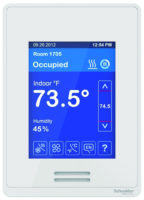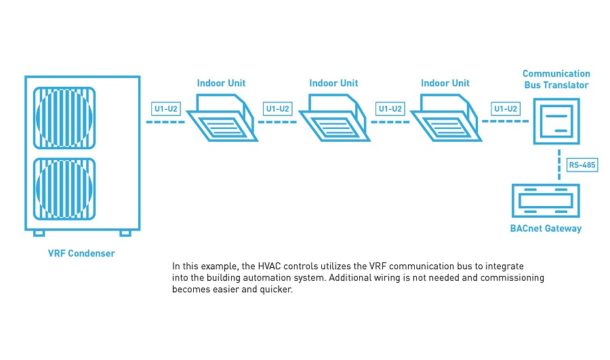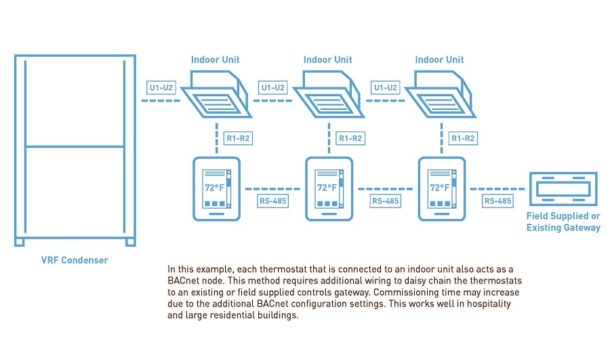Connected technology is permeating every aspect of our lives from the homes we live in, to the cars we drive and now, even the cities where we work. As smart cities gain popularity, smart buildings can act as the building blocks of a city’s infrastructure, but facility managers and building owners must get onboard with Read more
Variable Refrigerant Flow

Connected technology is permeating every aspect of our lives from the homes we live in, to the cars we drive and now, even the cities where we work. As smart cities gain popularity, smart buildings can act as the building blocks of a city’s infrastructure, but facility managers and building owners must get onboard with – and trained on – smart technology first.
In commercial buildings, one way connected environments can be created is through heating and air conditioning systems that respond to both occupancy and room conditions. This level of automation not only makes it easier for facility managers to operate buildings and keep spaces comfortable, but it also helps save on energy costs and reduces environmental impact, without compromising comfort or safety.
Creating a Customizable, Independently Operated Environment
As many commercial buildings have a multitude of different spaces to tend to, using smart, connected technology to cater to the heating and cooling needs of each space is key to ensuring a simplified building management process as well as occupant comfort.

Variable Refrigerant Flow (VRF) technology paired with smart connectivity controls dynamically offers not only temperature controllability but also cost savings, allowing facilities to manage equipment, lighting, security and electricity remotely from a single interface. With the ability to connect the system to optional door, ceiling, window and carbon dioxide sensors, a building can truly become “smart,” so that the heating and cooling technology automatically adjusts based on in-room conditions.
In a hospitality setting such as a hotel, this can be paramount to securing return visitors. By deploying in-room controls with customizable interfaces within each individual room, the hotel can begin to position itself as at the forefront of a smart hotel experience. With controls capable of custom welcome messages to guests and providing real-time updates on in-room conditions, guests will feel like they’re in a modern, personalized environment.
Similarly, an office environment can benefit from connected HVAC technology. If you’ve ever worked in an office that blasts air conditioning or neglects to use it, you know that temperature can directly impact employee productivity. With connected HVAC technology, workers can feel comfortable, reducing opportunities for distraction and keeping them focused on the task at hand.
Using HVAC Technology to Reduce Environmental Impact
According to the General Services Administration, VRF technology can save users up to 30% on HVAC energy costs, ultimately as a result of their smaller design, which uses less material than older, traditional HVAC equipment. Because these systems also use advanced technology to control temperature, they are more accurate and have a decreased margin of error, extending the lifecycle of the system and reducing the likelihood of maintenance or repair.

With cities consuming nearly 80% of energy production worldwide and an equal share of global greenhouse gas emissions, it is time for change – for the planet and for the bottom line. Smart cities, with tech-savvy smart buildings communicating through the Internet of Things and running on energy efficient technologies, can make a significant impact on global emissions and the lifespan and health of our planet. For business owners, technologies like VRF, among others, can reduce energy waste and in turn, energy costs, while improving tenant productivity and overall indoor comfort.
Propelling the HVAC Industry Forward
The answer is clear: It’s time for building owners, facility maintenance professionals and installation professionals to work together to maximize the value of smart buildings and cutting-edge heating and cooling technologies. As smart technology continues to change the way we live and work, the HVAC industry is in a perfect position to grow, and smart buildings equipped with connected HVAC technology are just another step towards a world full of more productive – and comfortable – cities and citizens.
 Malcolm Persaud is the National Sales and Product Manager – Commercial VRF for Panasonic’s Heating and Air Conditioning Group. Malcolm Persaud has a wealth of technical and sales leadership experience through the years with Sanyo and Panasonic. He was instrumental in Sanyo’s VRF successful sales launch and growth in the US market starting in 2005.
Malcolm Persaud is the National Sales and Product Manager – Commercial VRF for Panasonic’s Heating and Air Conditioning Group. Malcolm Persaud has a wealth of technical and sales leadership experience through the years with Sanyo and Panasonic. He was instrumental in Sanyo’s VRF successful sales launch and growth in the US market starting in 2005.
